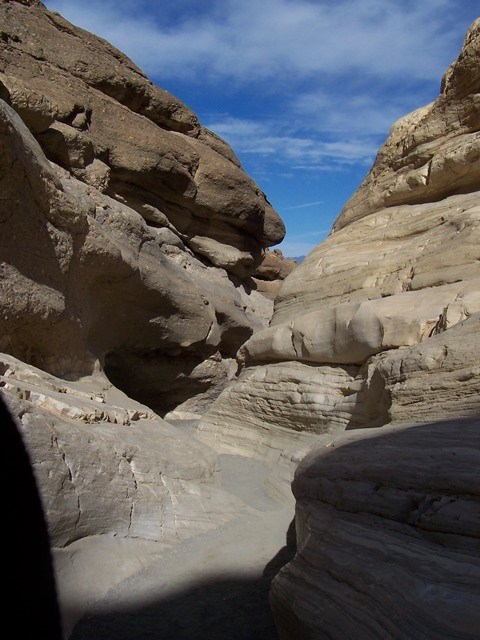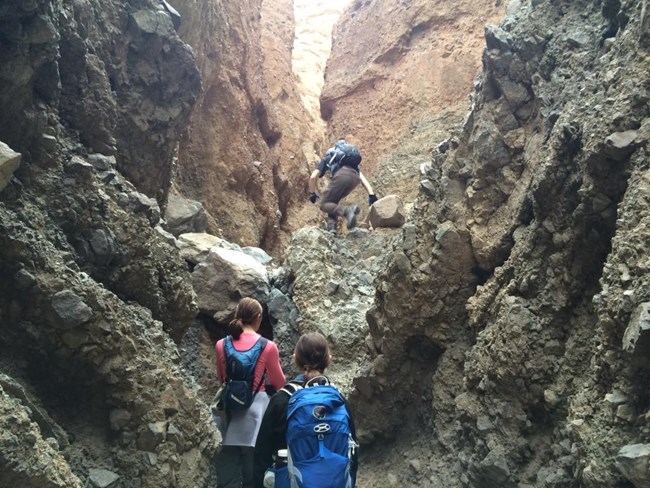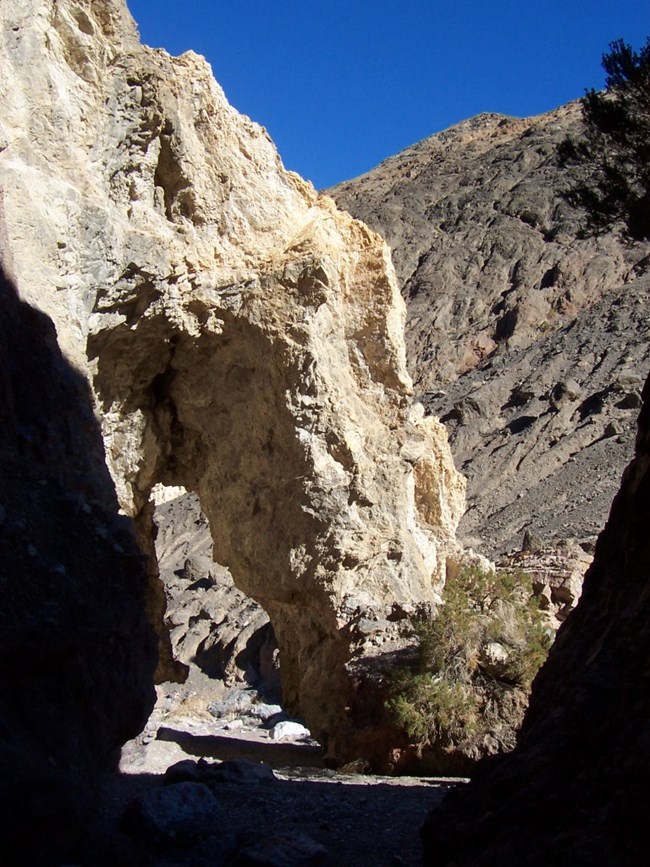|
There are few constructed trails here, but in a place this desolate you usually don't need them. Most hiking routes in the park are cross-country, up canyons, or along ridges. Hiking Seasons Water 
NPS/D.Kish Easy HikesHarmony Borax Works: 0.4 mi (0.6km)Salt Creek Interpretive Trail: 0.5 mi (0.8km) Badwater Salt Flat: 1 mi (1.6km) Natural Bridge: 1 mi (1.6km) Mesquite Flat Sand Dunes: 2 mi (3.2km) Moderate HikesUbehebe Crater Loop: 1.5 mi (2.4km)Darwin Falls: 7 mi (11.3 km) Badlands Loop: 2.7 mi (4.3km) Golden Canyon: 3 mi (4.8km) Desolation Canyon: 3.6 mi (5.8km) Mosaic Canyon: 4mi (6.4km) Willow Canyon: 4.2 mi (6.8km) Gower Gulch Loop: 4.3 mi (6.9km) Sidewinder Canyon: 5 mi (8.4km) Fall Canyon: 6 mi (9.6km) Dante's Ridge: 8 mi (13km) Difficult HikesPanamint Dunes: 7 mi (11.3km)Little Bridge Canyon: 7 mi (11.2km) Corkscrew Peak: 8 mi (12.9km) Wildrose Peak: 8.4 mi (13.5km) Telescope Peak: 14 mi (22.5km) 
NPS/K.Moses Harmony Borax WorksLength: 0.4 mi (0.6km) Paved loopTime: 30 minutes round trip Difficulty: Easy Elevation Gain: 50 ft (0.015km) Location: 1 mile (1.6km) west of Furnace Creek on CA-190 Parking: Paved area with large spaces for RV's and buses Closest Restroom: No restrooms. Furnace Creek Visitor Center 1 mile (1.6km) east. Route: The paved loop takes you back in time as you learn the stories of Death Valley borax and the 20-Mule Teams. Interpretive panels along the way explain details of the borax processing, the story of the Mule Skinner, life in Harmony, and more. 
NPS/K.Moses Salt Creek - ClosedLength: 0.5 mi (0.8km) ADA accessible wooden boardwalk loop CLOSED DUE TO FLOOD DAMAGETime: 30 minutes round trip Difficulty: Easy Elevation Gain: Flat Location: Salt Creek Road located 13 miles (20km) west of Furnace Creek on CA-190. The unpaved Salt Creek Road is typically passable to sedans. Parking: The open gravel parking area is large enough for RV's and buses. Closest Restroom: Vault toilets are located in the parking lot. Route: The boardwalk is open year-round, however, water only flows down to the boardwalk from November through May. The best time to visit is during the Spring (February - April) when the Salt Creek Pupfish are in spawn. Interpretive signs along the way explain pupfish behavior, their adaptations, and how they relate to other pupfish around the Mojave Desert. 
NPS/K.Moses Natural BridgeLength: 1 mi (1.6 km) out and back round tripTime: 45 minutes round trip Difficulty: Easy Elevation Gain: 86 ft (26m) Location: The unpaved Natural Bridge Road is 13.5 miles (22km) south of CA-190 on Badwater Road and is typically passable to sedans. Parking: Open parking area large enough for buses and RV's. Closest Restroom: Vault toilet located in parking lot. Route: The route from the information sign up the canyon to the bridge formation is easy to follow but very rocky. The canyon continues a short distance beyond the bridge where it abruptly ends at a dry waterfall. 
NPS/K.Moses Badwater Salt FlatLength: 1 mile (1.6km) out and back trip to edge of salt flat. 5 miles (8km) each way to the other side.Time: Average hiking speed is 2 mph (3.2 km/h), make your own adventure! Difficulty: Easy to difficult depending on length. It is flat. Do not attempt when it's hot! Elevation Gain: Flat Location: Badwater Road 30 minutes (17 miles/27km) south of Furnace Creek. Parking: Paved parking lot with large spaces for RV's and buses. Closest Restroom: Vault toilet located in parking lot. Route: The lowest point in North America is a beautiful salt flat covering over 200 square miles (322km) of the valley. ADA accessible ramp leads down to boardwalk. 
NPS/S.Stulberg Mesquite Flat Sand DunesLength: 2 miles (3.2km) round trip out and backTime: 1.5 hours round trip Difficulty: Easy to Moderate Elevation Gain: 185 ft (65m) Location: Located in Stovepipe Wells Village 30 minutes (24mi/39km) west of Furnace Creek. Parking: Paved lot with pull through spaces for buses and large RV's. Closest Restroom: Vault toilets located in parking lot. Route: The summit of the high dune is 1 mile (1.6km) each way. No formal trail. These are the most famous and accessible dunes in Death Valley. 
NPS/D.Kish Ubehebe Crater LoopLength: 1.5 mile (2.4km) loopTime: 1 hour round trip Difficulty: Moderate. Exposed edges! Not good for those with a fear of heights. Elevation Gain: 500 ft (152m) Location: 8 miles (13km) west of Scotty's Castle Parking: The paved lot directly overlooks the crater and is large enough for buses and large RV's. Closest Restroom: No restrooms. Nearest restrooms are located at the unstaffed Grapevine Ranger Station 5 miles (8km) east of the crater. Route: The hike is commonly done in a counter-clockwise direction where hikers begin with the uphill section first. Within 0.5 mi (0.8km) Little Hebe Crater comes into view and is a common destination for those looking for a shorter trip. 
NPS/C.Salomon Darwin FallsLength: 7 miles (11.3 km) out and back round tripTime: 2.5 - 5 hours round trip Difficulty: Moderate* Elevation Gain: 450 ft (137m) Location: Due to recent flooding, visitors must now park on the shoulder of CA-190 and hike to the trailhead. Trail conditions have changed. Heavy erosion has left debris and steep, unstable dirt edges. Hikers are advised to use caution. The unpaved Darwin Falls Road is located 1.2 miles (2km) west of Panamint Springs on CA-190. To the trailhead (first 2.5 mi/4km), Darwin Falls Road from CA-190 is typically passable to a sedan, however it is much more comfortable in a high clearance vehicle. Travelling from the town of Darwin to the trailhead is recommended for 4x4 high clearance vehicles only. Steep grades and unmarked intersections. Traveling to Darwin from the falls is not recommended. Parking: Small gravel parking area. Not recommended for large RVs. Closest Restrooms: No restrooms. The nearest facilities are located at the privately owned Panamint Springs Resort. Route: Unmarked. From the bulletin board head past the gate and into the wash up the canyon. The unmarked route is fairly flat but rocky as it transitions from a desert wash into a high walled canyon. Inside the canyon thick vegetation, stream crossings, and large slick rocks require that hikers use caution as they work their way deeper into the oasis. Please protect this fragile resource. No swimming! 
NPS/K.Moses Golden Canyon, Gower Gulch, and Badlands LoopLength: 3 to 8 miles (5 to 13km) routes.Time: 1.5 to 4.5 hours round trip depending on route. Difficulty: Moderate to Strenuous. Elevation Gain: 535 ft to 834ft (163m to 254m). Two Locations:
Closest Restroom: Located in both parking lots. Route: A maze of canyons and badlands create hiking opportunities galore. Go to the Golden Canyon page for route details, map, and GPS data. 
NPS/D.Kish Desolation CanyonLength: 3.6 mile (5.8km) out and back round tripTime: 2.5 hours round trip Difficulty: Moderate to Difficult Elevation Gain: 600 ft (183m) Location: The short unpaved Desolation Canyon Road is located 3.7 miles (6km) south of CA-190 on Badwater Road. Typically passable to sedans. Parking: Open gravel parking area large enough for buses and RV's. Closest Restroom: No restroom at site. Golden Canyon parking lot 1.7 miles (2.7km) north has a vault toilet in the parking lot. Route: Unmarked route with rock scrambling required. Go to the Desolation Canyon page for details. 
NPS/D.Kish Mosaic CanyonLength: 4 miles (6.4km) out and back round tripTime: 2.5 - 3 hours round trip Difficulty: Moderate to Difficult Elevation Gain: 1,200 ft (366m) Location: The 2.3 mile (3.7km) unpaved Mosaic Canyon Road is located in Stovepipe Wells Village just across from Stovepipe Wells Campground. The road is typically passable in a sedan. Parking: A large gravel parking area. Buses and large RV's not recommended. Closest Restroom: Stovepipe Wells Village at the general store and restaurant. Route: Many hikers choose to hike to the first set of beatiful canyon narrows less than 0.5 miles (0.8km) into the canyon. Check out the Mosaic Canyon page for a map, GPS data, and details about how to make this classic hike a longer adventure. 
NPS/D.Kish Willow CanyonLength: 4.2 miles (6.8km) out and back, round tripTime: 2.5 hours, round trip Difficulty: Moderate to Difficult Elevation Gain: 776 ft (237m) Location: An unmarked gravel access road is located on Badwater Road 31.5 miles south of CA-190 between mile markers 31 & 32. The access road is less than 0.5 miles (0.8km) long and is typically passable to a sedan. Same as Sidewinder Canyon. Parking: Open gravel area large enough for buses and RV's. Closest Restroom: No restrooms nearby. Follow principle 3 of Leave No Trace (LNT). Route: This route isn't very physically demanding, but finding the canyon and seasonal waterfall is a reward that only cross country navigators get to enjoy. No road and no hiking route signage. From the parking area avoid the small foothills and canyons to the east. Instead make your way north/northeast wrapping around the foothills and head toward the deep canyon in the mountains. Most of this route is across the rocky alluvial fan and exposed to the sun. The last 0.25 miles (0.4km) into the narrow canyon is over polished bedrock before ending at the waterfall. Visit the Sidewinder/Willow page for more route information. 
NPS/D.Kish Sidewinder CanyonLength: 5 miles (8.4km) out and back round tripTime: 6 hours round trip Difficulty: Moderate Elevation Gain: 1,580 ft (482m) Location: An unmarked gravel access road is located on Badwater Road 31.5 miles south of CA-190 between mile markers 31 & 32. The access road is less than 0.5 miles (0.8km) long and is typically passable to a sedan. Parking: Open gravel area large enough for buses and RV's. Same location as Willow Canyon. Closest Restroom: No restrooms nearby. Follow principle 3 of Leave No Trace (LNT). Route: See Sidewinder Canyon page for route information. 
NPS/D.Kish Fall CanyonLength: 6 miles (9.7km) out and back, round tripTime: 3.5 hours round trip Difficulty: Moderate to Difficult Elevation Gain: 2,460 ft (752m) Location: The 2.7 mile (4.3km) unpaved two-way section of Titus Canyon Road is located 11.9 miles north of CA-190 on Scotty's Castle Road. The road is typically passable to sedans. Parking: Open gravel parking area not recommended for large RV's or buses. Closest Restroom: Vault toilet in the parking lot. Route: See the Fall Canyon page for route information, a map, and GPS data. 
NPS/D.Kish Panamint DunesLength: 8 miles (12.8km) out and back 
NPS/D.Kish Little Bridge CanyonLength: 7 mile (11.2km) out and back, round trip.Time: 5 hours round trip. Difficulty: Difficult Elevation Gain: 1,900 ft (590m) Location: CA-190 at milemarker 89 eastbound. Parking: No official parking lot or signage. Park on the shoulder of the eastbound lane of CA-190 at milemarker 89. There is enough space for multiple vehicles, however large RV's are not recommended. Use caution along this high speed highway. Closest Restroom: One mile (1.6km) east, vault toilets are located in Mesquite Dunes parking lot. GPS Data: GPS data for the unmarked route is for supplemental purposes only. Take a map and compass when exploring the trail-less wilderness. Route: See the Little Bridge Canyon page for route information, a map, and GPS data. 
NPS/D.Kish Wildrose PeakLength: 8.4 miles (13.5km) out and back, round trip.Time: 6 hours round trip. Difficulty: Difficult Elevation Gain: 2,200 ft (671m) Location: From CA-190 follow Emigrant Canyon Road past the Wildrose Campground to the parking area at the Charcoal Kilns. The final 2 miles is a maintained gravel surface typically passable in a sedan. 25 ft vehicle limit. Parking: 25 ft vehicle limit. Open gravel area. Closest Restroom: Vault toilet in parking area. No restroom along the trail, follow principle 3 of Leave No Trace (LNT). Route: A great hike for when it starts getting too hot in the valley. Winter storms may bring some snow. See the Wildrose Peak page for route information, a map, and GPS data. 
NPS/E. Letterman Corkscrew PeakLength: 7.3 miles (11.7 km) out and back, roundtripTime: 5-6 hours round trip Difficulty: Difficult Elevation Gain: 3,080 feet (939 m) Location: Along Daylight Pass Road at 36.73458, -116.97209. Parking: There is a small parking area along the north side of the road. Closest Restroom: Hell's Gate Information Kiosk. Follow principle 3 of Leave No Trace (LNT). Route: The trail starts at an unmarked trailhead, and there is no designated trail. This route includes rock scrambling and route finding. 
NPS/D.Kish Telescope PeakLength: 14 mile (22.5km) out and back, round tripTime: 7 hours round trip Difficulty: Difficult Elevation Gain: 3,000 ft (914m) Location: From CA-190 follow Emigrant Canyon Road past the Wildrose Campground to the parking area at the Charcoal Kilns. The final 5 miles is a maintained gravel surface typically passable in a sedan. 25 ft vehicle limit. Parking: 25 ft vehicle limit. Open gravel area. Closest Restroom: Vault toilet in parking area. No restroom along the trail, follow principle 3 of Leave No Trace (LNT). GPS Data: GPS data for the unmarked route is for supplemental purposes only. Take a map and compass when exploring the trail-less wilderness. Route: Check out the Telescope Peak page for detailed descriptions, map, and GPS files for your trip. |
Last updated: August 4, 2025
